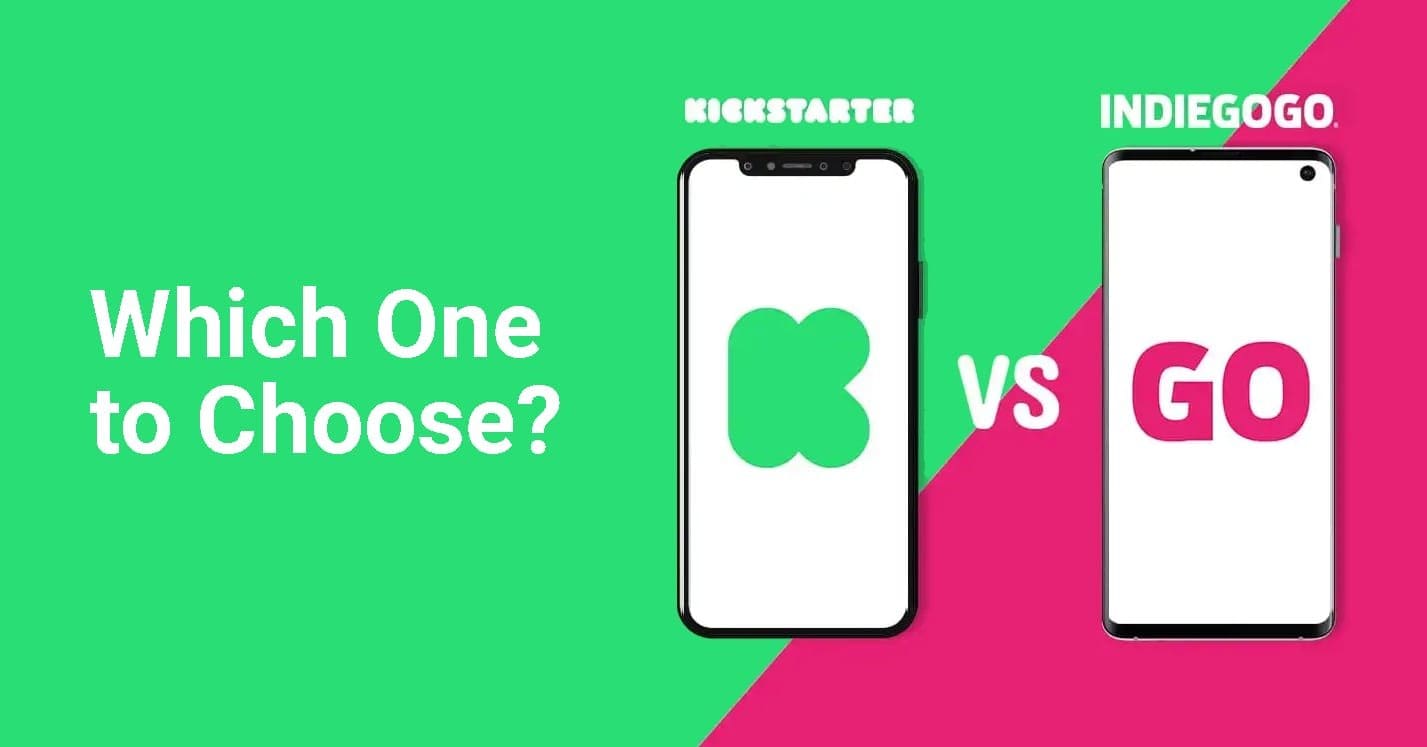Are you an aspiring creative looking for the best crowdfunding platform? Look no further! This article compares two of the most popular platforms, Indiegogo and Kickstarter, to help you determine which one suits your creative project better. With an in-depth analysis of the features, benefits, and success stories of both platforms, you'll be equipped with the knowledge to make an informed decision for your next big idea. So, let's dive in and explore the exciting world of crowdfunding for creative projects!

This image is property of blog.thecrowdfundingformula.com.
Comparing Indiegogo and Kickstarter
Overview of Indiegogo and Kickstarter
Indiegogo and Kickstarter are both popular crowdfunding platforms that have revolutionized the way creative projects are funded. With their user-friendly interfaces and wide reach, they have become go-to platforms for artists, entrepreneurs, and innovators seeking to turn their ideas into realities.
Key Similarities
Both Indiegogo and Kickstarter share several similarities that make them appealing choices for creative projects. Firstly, both platforms offer a simple and straightforward campaign creation process, allowing creators to easily showcase their projects and attract potential backers. Additionally, they both feature a wide range of project categories, allowing creators from various fields to find their niche audience.
Key Differences
While Indiegogo and Kickstarter have some similarities, they also have notable differences that may influence a creator's choice between the two. One key difference is the funding model. Kickstarter operates on an “all-or-nothing” funding model, where if a project fails to reach its funding goal, no money is collected from backers. In contrast, Indiegogo offers both fixed funding and flexible funding options, giving creators more flexibility in how they approach their campaigns.
Platform Features
Campaign Types
Indiegogo and Kickstarter support various campaign types to cater to different project needs. Both platforms offer standard campaigns, where creators seek monetary funding in return for rewards or early access to the project. Additionally, Indiegogo introduced InDemand, allowing creators to continue accepting contributions even after their initial campaign has ended. Kickstarter, on the other hand, recently introduced a feature called Drip, which enables creators to establish ongoing, subscription-style support from backers.
Funding Models
As mentioned earlier, Kickstarter follows an “all-or-nothing” funding model. This means that if a campaign fails to meet its predetermined funding goal, backers' pledges are canceled, and the creator receives no funds. Indiegogo, however, offers more flexibility with two funding options. Creators can choose between fixed funding, where they only receive funds if they meet their goal, or flexible funding, which allows them to keep any funds raised, regardless of whether the goal is reached.
Fees and Costs
Both Indiegogo and Kickstarter charge fees to cover platform costs and processing fees. Kickstarter charges a 5% fee on successfully funded projects, while Indiegogo charges a 5% fee for both fixed funding campaigns and 4% for flexible funding campaigns. Indiegogo also charges an additional processing fee of 3% plus $0.30 per transaction. It's important for creators to consider these costs when planning their campaigns.
Geographical Reach
Indiegogo and Kickstarter have different geographical reach. Kickstarter is available to creators in the United States, the United Kingdom, Canada, Australia, New Zealand, the Netherlands, Denmark, Ireland, Norway, and Sweden. Indiegogo, on the other hand, has a wider global reach, allowing creators from around the world to launch their campaigns and attract backers from various countries.
Project Categories
Both platforms have a wide range of project categories to accommodate different creative endeavors. Kickstarter focuses primarily on categories such as film, music, art, publishing, technology, and design. Indiegogo, on the other hand, offers a broader range of categories, including creative works, community projects, small business ventures, and even causes and charities. Creators should consider these differences when choosing a platform that aligns with their project's category.

This image is property of www.nextsmartship.com.
Project Approval Process
Indiegogo Approval Process
Indiegogo follows a relatively open approval process for projects. Creators can simply create and launch their campaigns without any upfront review. However, Indiegogo does monitor campaigns to ensure they comply with their terms of service and guidelines. This approach allows for more freedom and flexibility in launching campaigns.
Kickstarter Approval Process
Kickstarter has a stricter project approval process. Creators must submit their project for review by the Kickstarter team before it can go live. Kickstarter aims to ensure that the proposed project meets their guidelines and community standards. This review process helps maintain a certain level of quality and credibility for the Kickstarter platform.
Campaign Creation
Creating a Campaign on Indiegogo
Creating a campaign on Indiegogo is a straightforward process. Creators can start by signing up for an account and selecting the appropriate campaign type. They then provide details about their project, including its goal, duration, and rewards for backers. Indiegogo offers comprehensive customization options, allowing creators to design their campaign page to reflect their brand and vision.
Creating a Campaign on Kickstarter
To create a campaign on Kickstarter, creators need to begin by signing up for an account and submitting their project for review. Once approved, they can proceed with building their campaign page, providing details about their project, setting funding goals, and specifying rewards for backers. Kickstarter offers a range of customization options to ensure that creators can showcase their project effectively.
Design and Customization
Indiegogo and Kickstarter both offer customizable campaign pages, allowing creators to showcase their projects in a visually compelling manner. Indiegogo provides templates and customization options that allow creators to design their campaign page according to their brand aesthetics. Kickstarter offers a similar level of customization, enabling creators to personalize their campaign pages with images, videos, and project details.
Video Requirements
Both platforms strongly encourage creators to include a video in their campaign. Kickstarter considers videos to be vital in conveying the project's story and goals to potential backers. Indiegogo also recognizes the importance of videos and provides creators with guidelines and tips to create engaging videos that effectively communicate the project's message.

This image is property of cdn.aglty.io.
Campaign Promotion
Social Media Integration
Both Indiegogo and Kickstarter recognize the power of social media in promoting campaigns. They offer features to integrate social media platforms, allowing creators to leverage their existing social networks to reach a wider audience. Creators can synchronize their campaigns with Facebook, Twitter, and other social media platforms to generate buzz and attract potential backers.
Email Marketing
Email marketing plays a crucial role in campaign promotion. Indiegogo and Kickstarter allow creators to gather email addresses of potential backers by offering updates and news about the project. Creators can communicate with backers directly through email and use it as a tool for continuing engagement and generating support throughout the campaign.
Visibility Features
To increase the visibility of campaigns, both platforms offer various features. Kickstarter has a “Projects We Love” section, where they highlight outstanding projects that deserve more attention. Indiegogo provides a similar feature called “Indiegogo Picks,” showcasing campaigns with unique and innovative approaches. Both features help select projects gain more visibility and attract potential backers.
Campaign Updates
Keeping backers engaged and informed is essential for a successful campaign. Indiegogo and Kickstarter provide features that allow creators to regularly update backers about project progress, milestones, and any changes or additions to the campaign. These updates help maintain excitement and foster a sense of community between backers and creators.
Campaign Management
Backer Communication
Indiegogo and Kickstarter offer communication tools to facilitate interaction between creators and backers. Creators can send messages to backers, respond to inquiries, and provide updates on their campaign's progress. Clear and timely communication is important for maintaining trust and fostering a positive relationship with backers.
Pledge Management
Managing pledges and rewards is crucial for campaign success. Indiegogo and Kickstarter offer backer management tools, allowing creators to track and organize pledges, as well as manage reward fulfillment. These tools help simplify the management process and ensure that backers receive the rewards they pledged for.
Shipping and Fulfillment
For campaigns that involve physical products or rewards, shipping and fulfillment logistics are essential. Indiegogo and Kickstarter provide tools and resources to help creators manage shipping, including integrations with fulfillment services. These features assist creators in delivering rewards to backers efficiently and minimizing logistical challenges.
Refunding Backers
Sometimes unforeseen circumstances may arise, leading creators to need to refund backers. Indiegogo and Kickstarter have processes in place to handle such situations. Creators can communicate with the platforms and work together to issue refunds appropriately, ensuring that backers are satisfied and their support is valued.

This image is property of www.launchboom.com.
Success Rates
Statistics on Successful Projects
Both Indiegogo and Kickstarter have seen numerous successful projects across various categories. Kickstarter reports an average success rate of around 38%, with more than $6 billion pledged to projects since its inception. Indiegogo, on the other hand, boasts a success rate of around 13%, with millions of dollars raised for projects worldwide.
Factors Affecting Success
Several factors contribute to the success of a campaign on Indiegogo or Kickstarter. Quality and innovation of the project, effective marketing and promotion, solid backer engagement, and well-planned reward structures are all elements that can influence campaign success. Additionally, leveraging personal and professional networks and engaging with the platforms' communities can significantly impact a project's visibility and support.
Backer Experience
Backer Rewards
Both Indiegogo and Kickstarter value the importance of backer rewards. Creators on both platforms can offer a range of rewards based on the contribution level, providing incentives for backers to pledge their support. Rewards can vary widely, from early access to the final product, exclusive merchandise, personalized experiences, or even credits in the project itself.
Payment Methods
Indiegogo and Kickstarter allow backers to make contributions using various payment methods, including credit cards and some digital payment platforms. Offering multiple payment options enhances the convenience and accessibility for backers, increasing the chances of securing support.
Backer Support
Supporting campaigns on Indiegogo and Kickstarter comes with the assurance of a dedicated support system. Both platforms have customer support teams ready to assist backers with any questions, concerns, or issues they may encounter during the campaign or post-campaign period. The prompt and helpful nature of these support teams contributes to a positive backer experience.

This image is property of blog.thecrowdfundingformula.com.
Post-campaign Support
Post-campaign Options
Once a campaign ends, Indiegogo and Kickstarter offer different options for creators. Indiegogo has the InDemand feature, allowing creators to continue accepting contributions even after the initial campaign has concluded. Kickstarter, on the other hand, does not offer a post-campaign funding option directly on its platform. However, they allow creators to redirect backers to external websites if they wish to continue accepting funding.
Customer Support
Indiegogo and Kickstarter understand the importance of ongoing support for creators. Both platforms provide resources and guidance for creators during and after their campaigns. Whether it's through comprehensive knowledge bases, community forums, or direct customer support, creators can access the assistance they need to navigate the post-campaign phase successfully.
Community and Resources
Community Engagement
Both platforms have vibrant communities of creators and backers. Indiegogo and Kickstarter foster engagement through community pages, forums, and social media platforms. Creators can connect with like-minded individuals, seek advice, and build valuable relationships within these communities.
Guides and Resources
Indiegogo and Kickstarter offer in-depth guides and resources to assist creators in launching successful campaigns. These resources cover various topics, including campaign planning, marketing strategies, and best practices for engaging with backers. Access to these expert resources helps creators make informed decisions and optimize their campaigns for success.
In conclusion, Indiegogo and Kickstarter are excellent platforms for launching creative projects. While they share some similarities, they also have distinct differences that cater to different project needs. By considering factors like funding models, fees and costs, campaign management features, and community engagement opportunities, creators can determine which platform aligns best with their specific goals and project requirements. Ultimately, both platforms offer a wealth of resources and support to turn creative visions into reality.





